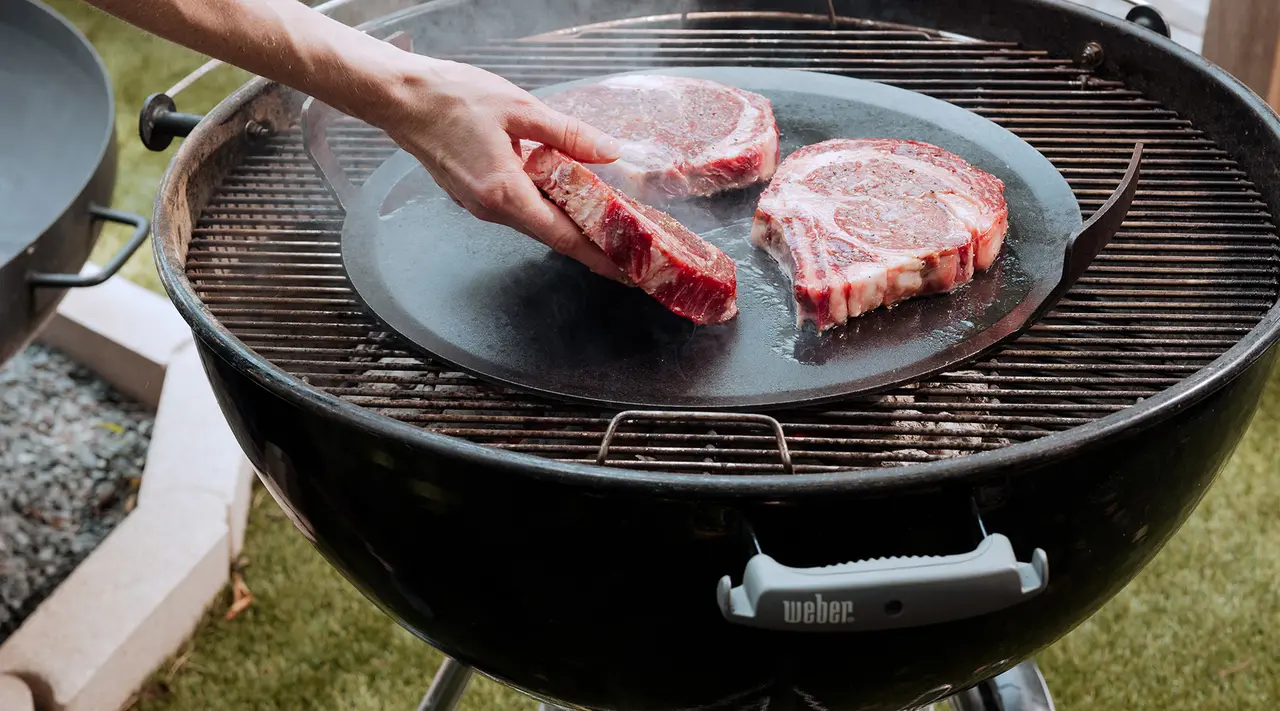If you haven’t tried dry-aged beef, let’s just say you’re seriously missing out.
This mouthwatering preparation is synonymous with the world’s top steakhouses, expensive restaurants, high-end butchers, holiday dinners and other special occasions. In other words, it’s super exclusive—and super pricey!
So, what’s the story with dry-aging? What is it, why do restaurants do it, and is it possible to execute at home?
Why dry age beef?
To start, it’s important to understand that ALL beef is aged to a certain extent. Once cattle are raised, slaughtered and cleaned, enzymes need time to break down and moisture must evaporate for the cut to achieve optimal flavor and texture.
Your local butcher or grocer likely covers beef in Saran wrap, puts it in the fridge, and calls it a day (the process is known as ‘wet drying’). This is perfectly fine, but for those in search of gourmet greatness, the ‘dry’ method takes aging to another level.
Assuming you have the time, patience and resources, dry-aging results in richer, meatier flavor and amazingly tender texture. The technique is quite a pain to implement, making it a truly special ‘treat.’
How do restaurants dry age beef?
Whether the process is performed by a butcher, the steakhouse itself or some other private preparer, there is very little variation in procedure. Beef is hung from the ceiling (think of the famous scene in Rocky) or placed on a rack to dry for anywhere from a week to months depending on your preferred outcome. No cling wrap. No coverings.
Over time, the meat’s exterior will begin to form a layer of mold as a result of air exposure. While you may think this spoils the beef, it’s actually the exact result you want. Right before cooking, the chef slices off this hardened crust to reveal the still-fresh cut underneath. And of course, it’s juicier and more flavorful than ever.
Why is dry-aged beef so expensive?
Exceptionally tender and bursting with deep, rich, beefy flavor, dry-aged steak is so delicious, it’s a mystery why butchers would bother with any other aging process. But despite all the foodie fanfare, there are plenty of downsides to this technique, which is why it is so expensive and hard to come by.
- The process takes awhile. Think of it this way. As a restaurant owner, you only have so much space in the walk-in. If the majority of your shelves are devoted to provisions that need weeks and weeks to age, that means less room for other ingredients you could serve up in seconds.
- The beef loses its weight. Unlike other methods, dry aging removes so much moisture that the cut loses up to a third of its original size. Some butchers even report as much as 40%. That’s a pretty big disappointment for consumers who equate BIG cuts with BIGGER value.
- You need high-quality meat. The process may be universal, but dry aging works best on high-grade meats, which have ideal fat content and distribution throughout the steak. This means preparation is not only time-consuming—but also costly!
Is dry aging worth it?
Yes. Please believe us.
Although the process sounds so painstaking, there’s a reason why the nation’s top steakhouses put this delicacy at the top of the menu (and command top prices for it).
On the topic of taste: Earlier, we described dry-aged beef as ‘rich’ in flavor. While wet-aged versions are more watery and bland, the steak’s natural ‘meat’ flavor is super concentrated when dry-aged. Also, the cheesy, moldy exterior (even after it’s removed) infuses the beef with a certain nuttiness—of course, in a pleasant way. The process adds another level of flavor that is truly delectable.
On the topic of texture: Exposure to air helps break down the beef’s enzymes much faster than typical aging. With muscle fibers mostly gone, the steak becomes incredibly tender, juicy, smooth and buttery. Absolutely no chewiness or gristle to be found. It may be smaller in size, but the meat’s density increases the longer it dry-ages. After the last bite, you’ll still be full and satisfied.
How to dry age beef at home
The average home chef isn’t working with a professional refrigerator box or similar supplies. But is it possible to dry age beef from the comfort of your kitchen? Absolutely. Clear out some room in the fridge, and let’s get to work.
We’ll start with a fairly simple, somewhat speedier method of dry aging. Online enthusiasts say it works great. Then, we’ll dive into some more professional details you may want to consider when dry aging beef at home.
The simple method
- Step 1: Go to a decent butcher or high-end supermarket and purchase a top-grade, USDA prime cut of beef, preferably of the large primal variety.
- Step 2: Clean the beef, completely dry with paper towels, and loosely wrap in cheesecloth. At this stage, do not trim any fat.
- Step 3: Place the meat on a rack over a baking tray, and set in fridge.
- Step 4: Let dry age in refrigerator for 3 to 7 days; periodically unwrap the cheesecloth and reapply to prevent the exterior from sticking.
- Step 5: Before baking, searing or grilling, remove the cheesecloth completely and use a sharp chef’s knife to cut away the dried crust that has formed. Leave most of the fat intact.
- Step 6: Slice into steaks or roast the entire thing, whatever way you like!
Tips for quality control
While this 6-step process seems relatively simple, experts say it’s not on par with the professional results you see in a world-class steakhouse. This is no surprise. Still, it’s best to start out easy, then work your way up to a more elaborate dry-aging production.
So, whether you’re just starting out or want to hone your craft, consider these key points while dry aging beef.
- Chefs say the ‘cheesecloth method’ dehydrates steaks, but doesn’t exactly ‘dry age’ them. While the results are similar, the pros recommend aging for a minimum of 2-3 weeks in order for enzymes to adequately break down (whether or not you cover the beef).
- Most home chefs don’t have a dedicated refrigerator for dry aging. Naturally, this comes highly recommended. The fact is, placing a fresh cut in the fridge with other foods will lead to flavor contamination. We know it’s a serious expense, but one worth considering.
- Place a small fan in the fridge to consistently circulate air and speed up the aging process.
- While 2-4 weeks helps tenderize the cut, experts say that rich, beefy taste is only achieved at 4-6 weeks, while a signature dry-aged aroma arrives at 6+ weeks.
- Avoid checking the beef at all costs. Open the door sparingly, as every time air escapes, moisture and airflow levels are ‘thrown off.’ You also run the risk of introducing odors from outside.
- Adjust your cook time to account for dry aging. Since the beef has less moisture, it’s easy to overcook the steak and dry it out even further. For so much work, ruining the cut would be a disaster!
Think you have the butchers’ gene? Let us know how it goes!
























